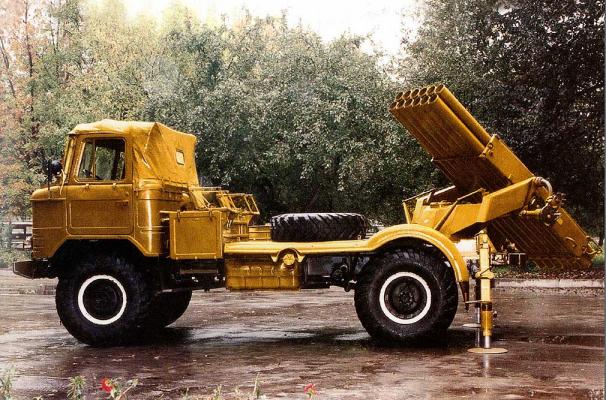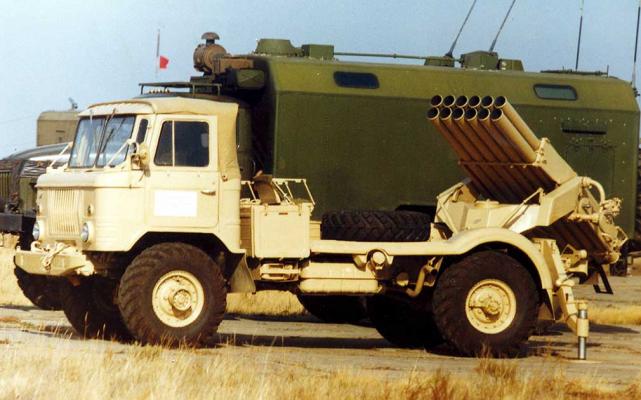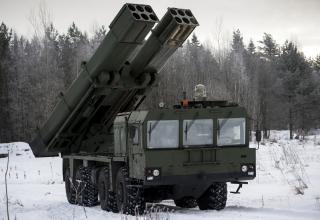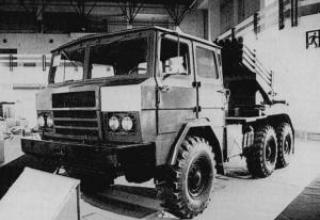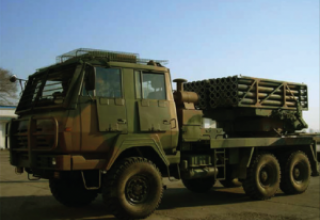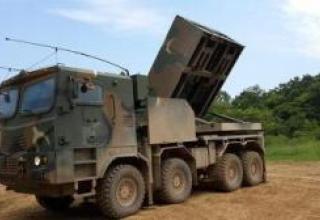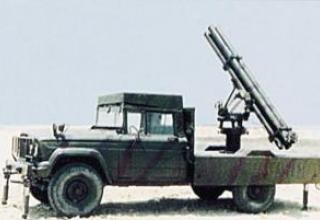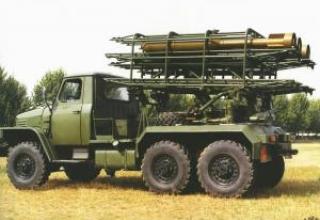The development of the "Grad V" rocket system (one of the designations during the development of the 9K51B), after the adoption of the M-21B Field Rocket System, also better known as the "Grad V" MLRS, for airborne troops was carried out on the basis of the plan approved by the Deputy Minister of Defense on December 26, 1963 and by the Chairman of the GKOT on December 16, 1963, according to the GRAU tactical and technical requirements No. 0010207 and changes to them, ref. No. a/113224 of June 13, 1966.
According to the data of the Central Archive of the Ministry of Defense of the Russian Federation, the following organizations were engaged in the system development: 276 MAPs - the head executor for the development of combat and transport vehicles and the system as a whole, 641 MAPs - the co-executor for the development of the parachute landing platform for dropping of combat and transport vehicles from AN-12 aircraft.
From the report to the Minister of Defense of the USSR Marshal of the Soviet Union Comrade Grechko A.A. from the Head of the Main Missile and Artillery Directorate (GRAU) Colonel-General of Artillery Kuleshov for the signatures of Lieutenant General of Artillery Peredelsky, Commander of Missile Forces and Artillery, and Colonel General Margelov, Commander of Airborne Troops (date 31.8.67) the following is known: "In June 1967 the testing of the Grad-B rocket system intended for the airborne troops was completed". "The development of the system was carried out by the State Design Bureau of Compressor Machine Building MAP (enterprise M-5380 and aggregate plant "Universal" MAP (enterprises V-2878) according to the plan approved by the Deputy Minister of Defence on 26.12.1963 and the Chairman of the GKOT 16.12.1963".
Due to the fact that the "Grad-B" system was developed "for the regular M21OF shell of the "Grad" system, the tests of the M21OF shell were not carried out".
Testing of the "Grad-V" rocket system was carried out according to the Directive of the Chief of General Staff ¹ 151123 of 23.11.66 according to the program approved by the Commander of the RViA and Commander of the Airborne Forces. Major General Ometov was the Chairman of the commission of polygon-artillery tests of the "Grad-V" jet system.
While carrying out testing of the "Grad-V" system in the course of preparing the vehicle for parachute assault, a number of significant remarks were revealed concerning the light top cab of GAZ-66 vehicle, which was manufactured and delivered to the company by M-5380 38th pilot plant of M.O. according to "Temporary meeting on provision of parachute assault of 9K51B system on P-128 platform" dated 17.02.65.
The main of them were:
- the windscreen in the landing position protruded over the length of the vehicle and it was not possible to protect it from parachute strings in flight.
- the cabin doors in the landing position protruded beyond the machine's width and could have been damaged during the landing process.
- The cabin arcs in the airborne position protruded beyond the machine's 1860 mm height.
The "Grad-B" rocket system, as compared to the towed RPU-14 rocket system in service with airborne troops, has the following main advantages:
- long range (20 km instead of 9.8 km);
- increased fragmentation effect of M-21of (1.5 times greater than that of M-14of);
- landing in loaded condition provides better maneuverability, cross-country capability and shorter engagement time after landing.
The Grad-B system can be effectively used in combat operations in the enemy's rear to defeat the enemy's manpower, firearms and materiel. The most expedient staff organization to use the "Grad-B" system is a division (consisting of 12 combat vehicles and 24 transport vehicles), which are part of the artillery regiment of the airborne division.
The "Grad-B" system was tested at 33491 r.m., 07264 r.m. and Strugokrasnensky range of the LVO".
See the data on parachuting tests of the system, as well as the draft document "On the adoption of the Soviet Army's airborne troops of the Grad V jet system.
By the decision of the STS GRAU dated August 3, 1967, the 9K51B system (one of the designations of the system in the CAME documents) was adopted for service with the Soviet Army.
In the report of the Head of the GRAU Kuleshov to the Minister of Defense of the USSR A.A. Grechko, the information about the adoption for service is given: "By the Order of the Ministry of Defense ¹ 0220 of September 20, 1967, the Soviet Airborne Troops adopted the M-21V multiple launch rocket system, which is parachuted in the charged state, which significantly increases the firepower and maneuverability of the Airborne Troops. For our part, we would like to note that in the issued Technical Description and Operating Instructions the name of the system is M-21V Field Rocket System.
After the system was adopted for service, it underwent modifications.
The M-21B system is intended for arming paratroopers, but it can also be used as a part of field mobile jet units.
For the combat vehicle, specific requirements to the combat equipment of airborne troops - increased reliability, compactness and light weight - are taken into account. The M-21B system can be airborne by means of a special parachute and jet system from various air carriers.
The system has been and can be in service with the Ground Forces of Iraq (no data available after the war), the Republic of Belarus, Russia (Airborne Forces) and Ukraine.
See the gallery on our site: demilitarized model of 9P125 RSZO "Grad V".
Composition:
The M-21B field jet system is a part of it:
- BM-21B (9P125) combat vehicle (see diagram, photo of BM prepared for amphibious assault, photo of amphibious assault platform);
- the M-21OF unguided projectile (see diagram);
- 9F37V transport vehicle (see general view, photo of TM prepared for parachuting).
The artillery part is mounted on the modified chassis of GAZ-66B truck. GAZ-66B landing vehicle was adopted by the Soviet Army in accordance with the Order of the Defense Ministry No 38 of March 2, 1966. Two remote mechanical jacks are placed in the rear part of the combat vehicle, which increases the combat vehicle stability when firing. The type of vertical and horizontal guidance drives is manual.
The combat vehicle can be used for single and multiple rocket launcher firing from a firing position that does not require training on slopes of up to 4°. Full salvo time is 6 seconds. When in combat use, the BM-21B and 9F37B vehicles can be used jointly or independently. Charging of the tubular package (see the layout) of the BM-21B combat vehicle shall be performed manually both from the 9F37B transport vehicle and from the ground. The tubular package of the BM-21V shall be discharged manually both to the 9F37V and from the ground. The vehicles of the system can be operated at any time of year and day, in any weather conditions at ambient air temperatures ranging from -40°C to +50°C and relative humidity up to 90% (at temperatures below 20°C), with wind speed up to 20 m/sec.
Ammunition from "Grad" and "Grad-1" can be used for firing. Taking into account that the RM-70, RM-70/85 and RM-70/85M foreign combat vehicles can be used to launch projectiles from the "Grad" MLRS, it is possible to assume that projectiles for the above-mentioned foreign BMs can be launched with the domestic BM-21 and, in particular, with the BM-21B. The main (regular) projectile is the M-21OF fragmentation-phase projectile (see description). The maximum range with this projectile is 20.4 kilometres. New generation projectiles with extended range can also be launched.
Characteristics:
| Number of tubular guides | 12 |
| Inner diameter of the guideway, mm | 122.4 |
| The corners of the elevation of the package in the sector bypassing the cabin, hail: - in sector ±30° horizontally - from ±30° to 70° horizon |
15° to 54° 0° to 54° |
| Angle of horizontal fire, hail: - to the right of the chassis axle - to the left of the driving axle |
70 70 |
| Guide bag pointing speed: - at an elevation - azimuthally |
2° per flywheel rotation 2° per flywheel rotation |
| Force on the handwheel handles of guidance drives, kg | not more than 10 |
| Dimensions in camping position, mm: - length - width - altitude |
5655 2400 2440 |
| The weight of a combat vehicle, kg: - without shells - loaded with charges, numbered |
not more than 5200 not more than 6000 |
| The chassis: - base, mm - ground clearance, mm - wheel track, mm |
3300 315 1800 |
| Maximum travel speed for a fully equipped and loaded vehicle, km/h. | 85 |
| Maximum power reserve, km | 875 |
| Deployment time (transfer of shrouded vehicle from camping to combat position), mines | not more than 3.5 |
| Turn-off time (moving the vehicle from a combat position to a camping site), mines | not more than 3.5 |
| Charging time in day (night) conditions from the ground or transport vehicle 9F37B, min. | not more than 5 |
| Full salvo time, sec | 6 |
| Front eating angle, degree. | 41 |
| Calculation, man. | 2 |
Testing:
In the period from October 10, 1969 to December 20, 1969, at the P6766 substation enterprise, the "cassette warfare unit for antipersonnel mining to the "Partizan" system was tested (subject MKV2-6I-69)". See photo.
See also the Conclusion on the results of the tests of the upgraded Grad-P mobile jet system. (cipher - "Partisan")
Alekseev Alexander Timofeyevich, worker of the Central KIB SOO Alekseev took part in the creation of the launch unit 9P132.
Sources:
- Полевая реактивная система М-21В. Техническое описание и инструкция по эксплуатации. Книга 1. Техническое описание и инструкция по эксплуатации. Ордена Красного Знамени Военное издательство Министерства обороны СССР. М.: 1975. – C. 13, 15.
- Полевая реактивная система М-21В. Техническое описание и инструкция по эксплуатации. Книга 2. Альбом рисунков. Воениздат. М.: 1975. С. 55, 75.
- Научно-производственное предприятие “Старт”. 60. 1949-2009. Настенный календарь.
- ЦАМО РФ. Ф.81. Оп.856348сс. Д.97. ЛЛ.24,25,64,89,91,104,105,240,241,271,390,401.
- ЦАМО РФ. Ф.81. Оп.856348сс. Д.323. Л.150.
